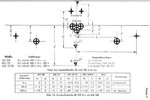thewritingwriter89
Airman 1st Class
(With regard to the 'trim due to flaps automatically corrected' bit: The Me 110 actually changed the tailplane incidence in unison with the flap movement to achieve just that. Normal elevator trim was achieved by trim tabs, only the compensation for flap deflection was achived by moving the tailplane.
So in other words, the normal "nose down" response from lowering flaps is counteracted by an increase in "pitch up" elevator trim?


